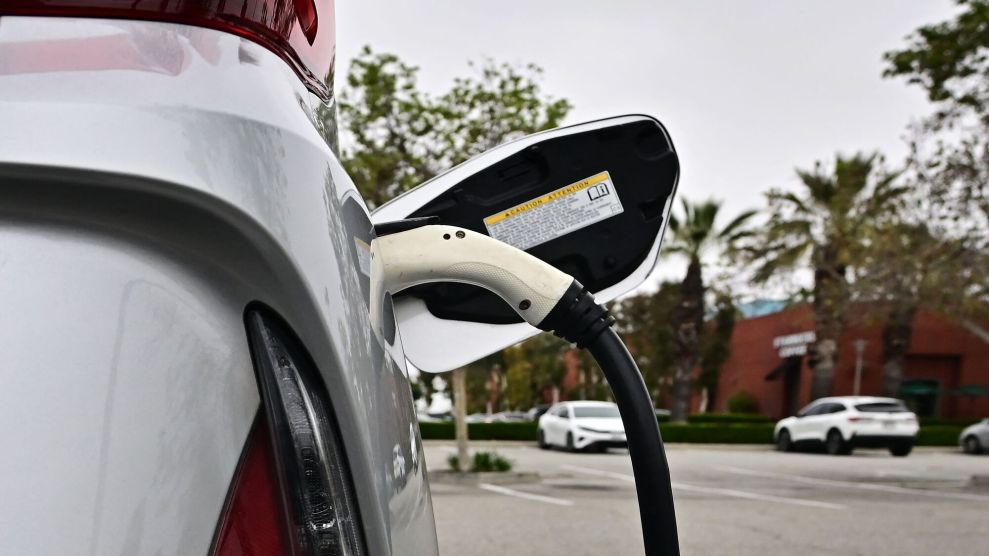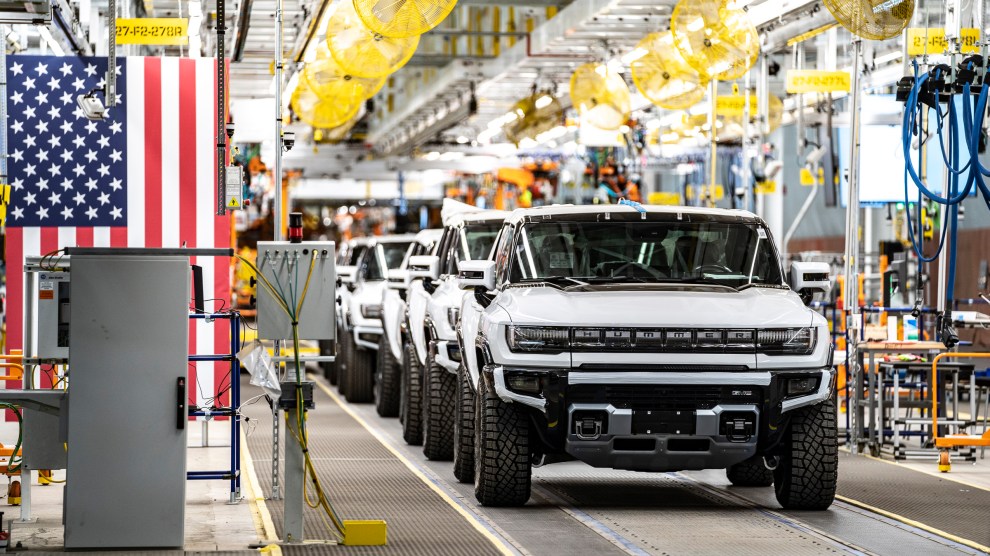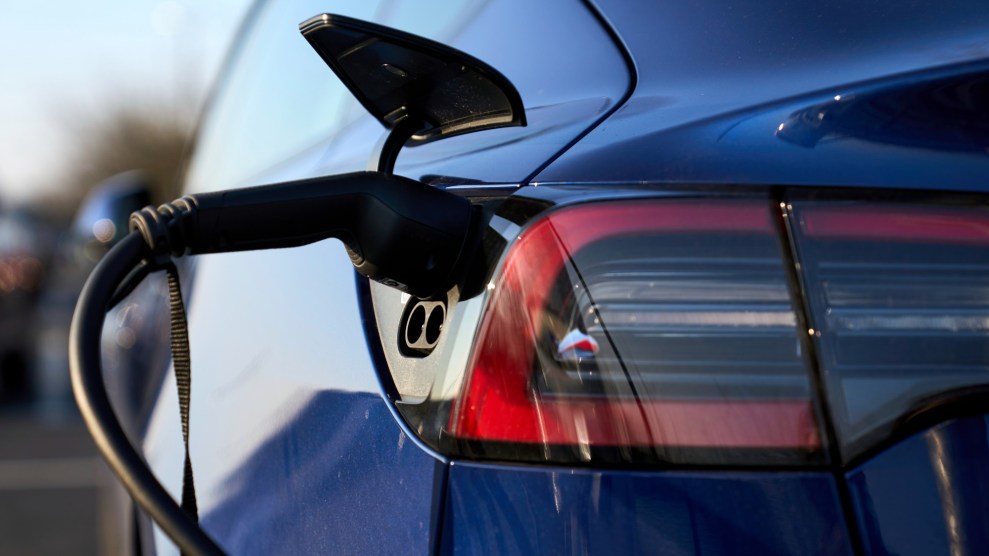
An electric vehicle is charged in Alhambra, California, on April 12, 2023. Frederic J. Brown/AFP/Getty
This story was originally published by Slate and is reproduced here as part of the Climate Desk collaboration.
President Joe Biden, whose own press releases refer to him as a “car enthusiast,” may have just signed a death warrant for the gas-powered car.
On Wednesday, the Environmental Protection Agency proposed aggressive rules to curb air pollutants and carbon emissions from vehicles sold in the US from 2027 onward—and, in the process, phase more fossil-fueled vehicles out of the domestic market by 2032. Rather than force carmakers to sell a specific number of electric vehicles by that point, the announced regulation sets a cap on the total lifetime emissions that stand to be released from a given company’s annual product fleet. In essence, the EPA is pushing to increase the number of electric cars on the market by raising the quality gauge for automakers, with varying expectations based on product size. From 2026 through 2032, the EPA expects a 56 percent emissions reduction from new light-duty vehicles—cars, vans, pickup trucks—and a 44 percent emissions reduction from new medium-duty vehicles, like firetrucks and box trucks. Such substantial cuts would be gained by displacing gas-powered vehicles with zero-emission EVs; the EPA anticipates that electric models could make for nearly half of medium-duty sales and two-thirds of light-duty sales by 2032.
That’s right: The Biden administration wants the US auto market to be majority-electric in less than 10 years, which is why it’s calling these measures “the most ambitious pollution standards ever,” as EPA Administrator Michael Regan put it. Certainly, the proposal adds pressure to an industry facing intense calls to literally clean up its act. At the 2021 United Nations Climate Conference, 30 major nations and six auto corporations signed a nonbinding pledge to halt sales of gas-powered passenger vehicles by 2040 at the latest. However, some governments have since moved up their benchmark in the interest of climate action, despite significant pushback from Big Auto. Seven US states are straight-up banning sales of new gasoline-burning cars by 2035, with California requiring its auto market to be 68 percent electric by 2030. The European Union made its 27 member countries join the party. Brexit couldn’t stop the United Kingdom from implementing its own auto standards in 2020: a ban on new gas cars by 2030, and a ban on new hybrids by 2035.
Citing the Inflation Reduction Act’s EV credits and domestic-manufacturing guidelines, as well as the Bipartisan Infrastructure Law’s funding for energy transmission and EV chargers, the Biden administration declared that the framework is already in place for us to meet this goal. Naturally, the car and oil companies don’t believe so—and their skepticism isn’t entirely unwarranted. From one vantage point, the challenge appears insurmountable. Only 5.7 percent of new cars sold in the U.S. last year were fully electric; EV chargers aren’t widely available; lingering supply-chain kinks are holding up supplies (and heightening prices) of key car ingredients like semiconductors and battery parts; consumer sentiment toward EVs, while improving, is still hampered by their higher costs and electricity demands; the government’s refreshed tax credits come with domestic-production requirements that leave some foreign-made EVs in the cold.
Viewed from another angle, however, these obstacles aren’t as forbidding as they appear. EV purchases are low because of the cost? Consider that 2022 saw a 65 percent leap in electric sales from the year prior, even as the entire sector hiked up prices; now, those prices are going back down, and sales of new and used models continue to surge this year. (Don’t forget: While a good EV may be costlier than a gas car at the dealership, it more than pays for itself in lifetime savings.) We don’t have a sufficient charging network, and EVs need a lot of power? Cities are rapidly installing chargers on streets and buildings, and Elon Musk is opening up Tesla’s Superchargers to non-Tesla EVs. At any rate, car batteries are improving in efficiency, charge capacity, and overall life span; remember, too, that you can charge your car at home and even utilize it for other power needs. The industry depends too much on overseas trade? The operation and construction of domestic battery-, chip-, and EV-manufacturing plants are in full swing.
One lesser-discussed, particularly knotty issue does remain: all the mining that needs to be done.
Electric vehicles may not emit greenhouse gases, but they do require extraction of minerals and metals from the ground: lithium, cobalt, graphite, copper, nickel, and manganese for common battery types, as well as rare earth elements for electric motors and semiconductors. An electric rush will only be possible if there’s ample supply of these resources, which are already used in countless modern tech products (smartphones, data centers, air conditioners). The EV sector’s boosted competition will spur some ugly land grabs to open up mines, in addition to the land grabs already in motion for establishing the car, chip, and battery factories.
To be clear, an electrified economy would require far less mining than the fossil-fueled status quo, and mass EV adoption would help by displacing cars that depend on oil and gasoline. Still, electric vehicles add significant mining demand to the clean-energy transition. In January, the the Climate and Community Project think tank released a report laying out specific means by which a clean-energy power sector could avoid excessive mining: constricting battery sizes, improving the lithium- and battery-recycling process—and, notably, improving public transit so as to reduce personal-vehicle use and demand. Indeed, why stop at ditching gas cars when you ditch cars altogether? Maybe the EPA can next look into that next.
















